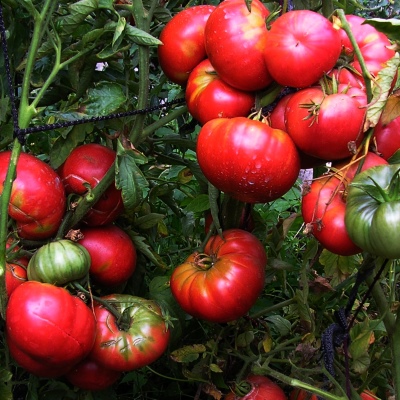
- Authors: Myazina L.A.
- Year of approval: 2007
- Name synonyms: Mamont
- Category: grade
- Growth type: indeterminate
- Appointment: fresh consumption
- Ripening period: early
- Ripening time, days: 90-100
- Growing conditions: for open ground, for film greenhouses
- Bush height, cm: 170
Tomato Mammoth got such a loud name for a reason. It is truly telling: ripe tomatoes of this variety are gigantic in size and weight. What other characteristics does the Mammoth tomato have, and how to grow it on your site - read further in the article.
Description of the variety
Mammoth is a large-fruited variety of unlimited growth, intended for planting in a greenhouse, as well as in the open field. Suitable for growing in most regions of our country.
A shrub with a standard leaf shape is an indeterminate plant that can grow up to 2 meters tall when planted outdoors. The average height of the bush is 1.5 meters. Requires a garter, pinching and bush formation.
Refers to mid-season and high-yielding varieties. Possesses good keeping quality (up to 2 weeks) and transportability. It has good immunity to diseases and pests. Resistant to dry climates.
Due to its excellent taste, it is excellent for fresh consumption, and is also widely used in cooking for preparing various dishes.
The main qualities of the fruit
Mammoth tomatoes are usually very large in size. The weight of one ripe fruit can reach a kilogram. Average weight - 250 g.
Tomatoes are rounded, slightly flattened from top to bottom. The skin is firm but tender. The color is pink. On the cut - bright, juicy, fleshy.
Taste characteristics
Tomato Mammoth has excellent taste. Delicate skin, sweet and juicy pulp, pleasant aroma allow this variety to be eaten fresh.
Mammoth tomato is especially good in salads with fresh vegetables. And also ripe tomatoes are used by housewives for making sauces, snacks, lecho, juices. This variety is not suitable for canning only. The reason for this is the large size of the fruit.
Ripening and fruiting
The crop ripens after 100-115 days from the moment of planting - the variety is mid-season. Fruiting throughout the season.
Yield
The yield is high - by creating favorable conditions for the tomatoes, you can get 5-10 kg of ripe fruits from one bush.
The timing of planting seedlings and planting in the ground
Sowing tomato seeds for seedlings Mammoth is usually carried out in late February - early March. You can sow in a common container, but as soon as the first two leaves appear on the seedlings, it must be dived into separate containers, for example, into peat tablets.
In open ground, seedlings can be planted after 2 months from the moment of sowing the seeds. You should also focus on the weather in the region - the threat of frost should be avoided, and the soil should warm up.

Growing tomato seedlings is an extremely important process, because it largely depends on whether the gardener will be able to harvest at all. All aspects must be taken into account, from seedbed preparation to planting in the ground.
Landing scheme
The bushes are characterized by high and voluminous growth, therefore, the Mammoth tomato must be planted in such a way that there are no more than 3 plants per square meter of the plot.

Growing and care
This variety is attractive not only for its size and taste, but also for the fact that it does not require complex maintenance.
Tall plants need to be tied to a support, as well as pinned. It is best to form a bush into 2 stems.
The variety is drought-resistant, but you should still organize regular adequate watering for the tomatoes as the soil dries, without waterlogging. And also more often to loosen the soil and remove weeds in a timely manner.
It does not require top dressing, but if the bush does not grow as well as we would like, you can feed it with a special mineral composition or organic fertilizers. From organic matter, humus or compost is perfect.
All fertilizers must first be diluted in water and applied at the root by watering.




A plant needs different micronutrients at each stage of growth. All fertilizers can be divided into two groups: mineral and organic. Folk remedies are often used: iodine, yeast, bird droppings, eggshells.
It is important to observe the rate and period of feeding. This also applies to folk remedies and organic fertilizers.
Disease and pest resistance
The variety has good immunity. It is resistant to major diseases and pests that commonly affect the nightshade family. But do not overmoisten the soil - in this case, there is a risk of damage to the root system of the plant with fungal infections and rot.


Resistant to adverse weather conditions
The variety thrives equally well in different climatic zones. Perfectly adapts to hot summers and droughts.

























































































